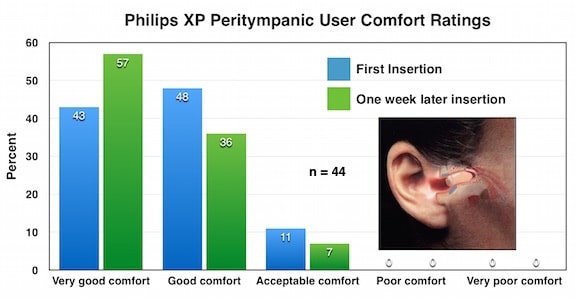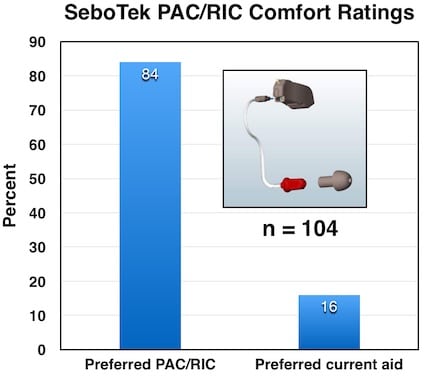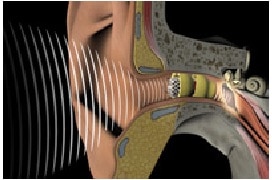Deep Fitting Ear Canal Device Physical Comfort
A plethora of products are worn in the ear canal – some more deeply than others. Regardless, not all devices that fit into the ear canal are comfortable. Physical comfort depends on at least the following factors:
- Ear canal sensitivity
- Size, as in volume, of the device being inserted relative to the size of the ear canal
- Configuration of the device being inserted relative to the configuration of the ear canal
- Hardness and composition of the device being inserted
- Design of the inserted product
- Depth to which the device is being inserted
- Magnitude of the turns of the ear canal
- Time worn (e.g., hrs./day)
- Time worn (e.g. long-term experience)
- Voluntary or mandated wear
- Etc.
The limited literature relative to the actual physical comfort of ear-inserted devices is difficult to compare because devices differ by design and use (earplugs, hearing aids, in-ear canal headphones, other hearables). Of interest in this post is the comfort reported when the fitting tip makes contact with the bony structure of the ear canal – devices worn more deeply than in just the outer cartilaginous ear canal.
The ear insert device that is most likely to have the greatest long-time wearing schedule by a user is the hearing aid. It is not uncommon for 12-hour daily usage. Therefore, this short post will review some limited data based on hearing aids, but only those that were designed to fit more deeply into the ear canal. These were unvented instruments intended to take advantage of the acoustic properties of having the speaker/receiver located in closer proximity to the tympanic membrane than had previous hearing aids, and that were designed also to improve wearing cosmetics. The question to be answered related to the physical comfort to products worn more deeply in the canal, especially amplification products.
Approximate Physical Comfort Acceptance
Philips XP Peritympanic
The first real attempt at a deep fitting hearing aid was the Philips XP Peritympanic{{1}}[[1]] Staab, W.J., “The Peritympanic Instrument: Fitting Rationale and Test Results,” THE HEARING JOURNAL, Vol. 45, No. 10, pp 21-26, October, 1992[[1]]. First-time users of this custom-molded hearing aid were fitted with the device that terminated in the bony portion of the ear canal. Results are shown in Figure 2 (102% due to rounding errors). This was an unvented hearing aid.

Figure 1. User wearing comfort ratings for the Philips XP Peritympanic hearing aid that fit deeply into the ear canal to the level of the bony structure.
Songbird Disposable
Songbird was a disposable hearing aid designed to fit into the bony canal{{2}}[[2]] Staab W.J, Sjursen W, Preves D, and Squeglia T. A one–size disposable hearing aid is introduced. Hearing Journal, 2000:53(4):36, 38–40[[2]]. Various versions (same housing) allowed for different response and gain performance, and for different tip sizes to manage the range of ear canal sizes. Results are shown for a “first-time” experience. Later studies provided comfort ratings for repeated use.

Figure 2. Physical comfort of first time user ratings of the Songbird disposable hearing aid.
SeboTek PAC/RIC
A number of user preferences were measured between the SeboTek Voice-Q PAC hearing instrument to the hearing instrument(s) that the user was presently wearing. Patients were asked to rate the two instruments in areas that most often determine the user’s satisfaction level with their hearing instruments. Areas considered were sound quality, comfort, cosmetics and sound of voices. The data here are directed toward “comfort.” Comparison of comfort was made against all type of hearing aids. The original product design is shown in Figure 3, along with the results. Keep in mind that there were no comparable hearing aids to the SeboTek to which comparisons could be made.

Figure 3. SeboTek PAC/RIC hearing aid comfort compared to the hearing aid the subjects were then wearing.
Unique to the SeboTek was the separation of the processor and the speaker, enclosing the hearing aid speaker in a special soft tip, and made to fit deeply within the ear canal. This disruptive invention resulted in a massive change in the way hearing aids are designed. Originally called the PAC (post-auricular canal), it is identified today as the RIC (Receiver in the Ear) hearing aid{{3}}[[3]]Staab, W.J. and Nunley, J. PAC: Post-Auricular Canal. American Academy of Audiology, San Antonio, TX, April, 2003[[3]]. Figure 3 shows the results.
Lyric Hearing Aid

Figure 4. The Lyric semi stock/custom hearing aid designed to fit deeply within the ear canal, close to the tympanic membrane.
The Lyric is a canal hearing aid fit deeply within the ear canal (Figure 4). It is referred to as a semi stock/custom device, and allows for 24-hour continuous use for up to four months. Initial fitting results of comfort were based on those who could be fitted, and not on a general population as in the previous studies. Of the 55 who could wear the product, after one month 94% rated the comfort as satisfactory or very satisfactory (from early Lyric PR data, number of subjects who could not wear the device was not provided). If more recent wearing statistics are available, they are not produced on the Lyric web site. A more recent review of the Lyric offers good insight into observations and patient experiences{{4}}[[4]]Sanford, M.J., Anderson, T., and Sanford, C. The extended wear hearing device: Observations on patient experiences and its integration into a practice, March, 2014, Hearing Review[[4]].
Summary
The purpose of this post was to show that technology has led to a systematic improvement in the comfort of hearing devices fitting deeply within the ear canal. Most of this improvement has been the direct result of miniaturization of components, allowing for components to be housed in a smaller package. In other cases, the composition of the device itself, especially the fitting tip construction, has assisted in the comfort of those hearing aids extending into the bony structure of the ear canal. The case of the Lyric is, however, somewhat different from those devices that fit in the ear canal, but extend into the bony canal, because most of those devices have significantly less exposure that deep in the canal. It is known that ears accommodate to devices placed in them, and that the comfort acceptance improves anywhere from a few days to approximately one-month maximum. Armchair logic suggests, however, that Lyric-type devices may take a longer accommodation time for the user to find them comfortable.







dear Dr Staab
Thank you very much for your article above . I need to mention every time I read your articles about hearing matters it’s so interesting that I look for the future to read your new writings .
By the way would you please be kind enough to foreward some hearing aids manufacturers name and address in LA as my brother in law has recently moved there from Frankfurt
Searching for a carrier in hearing aid assembly that he is 25 years experienced in .
With lots of thank and appreciations.
Yours. Mohammad ali nourmohammadian.